© Copyright Atlanta Coin Expositions, 2008-2025. All Rights Reserved.
Several of the links on the pages within this web site go to affiliate vendors.
A vendor affiliation can mean a small monetary compensation to the web site owner at no additional cost to you.
Several of the links on the pages within this web site go to affiliate vendors.
A vendor affiliation can mean a small monetary compensation to the web site owner at no additional cost to you.
Coin Show
Information
Shop
General
Next Monthly Coin Show
Coin Show - Monthly Notes for August 2020
Collectible Soldier Ornament
Bags of Silver Coins
American Silver Eagle Coins
International Gold Bullion Coins
1795 Flowing Hair Silver Dollar Coin - Two Leaves
1798 Draped Bust Silver Dollar Coin - Large Eagle
1800 Draped Bust Silver Dollar Coin - Wide Date, Low 8
The August 2020 Greater Atlanta Coin Show occurred on a pleasant summer day, and the show welcomed many visitors to the bourse with tables spread for social distancing among the dealers and collectibles.
We appreciate everyone that helped make the August show a success from the dealers to the visitors to the security and especially to the hotel that once again provided more space for the show. A big THANK YOU to one and all.
For a summer day in August, which can unbearably hot in Hotlanta, this Sunday was pleasant. Under mostly sunny skies, the temperature did rise into the 90s, but the humidity was not high, making it a beautiful day for us and our guests to be out and attending a coin show.
We appreciate everyone that helped make the August show a success from the dealers to the visitors to the security and especially to the hotel that once again provided more space for the show. A big THANK YOU to one and all.
For a summer day in August, which can unbearably hot in Hotlanta, this Sunday was pleasant. Under mostly sunny skies, the temperature did rise into the 90s, but the humidity was not high, making it a beautiful day for us and our guests to be out and attending a coin show.
The hotel still operates with a decreased staff since fewer people are traveling these days. As such, there wasn't much activity at the hotel other than our event.
As for the show, our busiest time occurred from 9 am to 11 am. The afternoon visitors taper off such that many dealers, especially those with long drives, leave the show early.
This month, the show's dealers and attendees enjoyed discussing many topics in addition to browsing the displays.
As for the show, our busiest time occurred from 9 am to 11 am. The afternoon visitors taper off such that many dealers, especially those with long drives, leave the show early.
This month, the show's dealers and attendees enjoyed discussing many topics in addition to browsing the displays.
Of course, a primary topic was the increase in the precious metals prices. Did you notice that an ounce of silver increased not quite $10 from the Friday before the July show to the Friday before the August show?
Comparably, gold's value increased from $1798.60 to $2034.80 per ounce, an increase of just over $236.
Other topics included the riots and damage occurring locally and around the country, the start of schools amid the COVID-19 concerns.
There were also discussions of whether the Blue Ridge Numismatic Association would be able to hold their annual August show in Dalton. (They did.)
One specific item of note, we attached signage to the doors alerting everyone that beginning for the September show, masks will be required to enter the show.
Make a mental note to remember to bring your mask to the next show.
Now, let's take a look at a small sampling of items seen on the bourse:
Comparably, gold's value increased from $1798.60 to $2034.80 per ounce, an increase of just over $236.
Other topics included the riots and damage occurring locally and around the country, the start of schools amid the COVID-19 concerns.
There were also discussions of whether the Blue Ridge Numismatic Association would be able to hold their annual August show in Dalton. (They did.)
One specific item of note, we attached signage to the doors alerting everyone that beginning for the September show, masks will be required to enter the show.
Make a mental note to remember to bring your mask to the next show.
Now, let's take a look at a small sampling of items seen on the bourse:
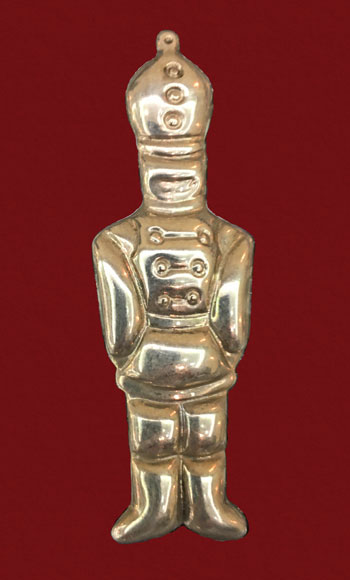
He appears to be a brass soldier.
Now, searching the internet, he could be from a retired Department 56 collection.
Department 56 is a U.S. manufacturer of holiday collectibles, ornaments and giftware. Popular items include lighted Christmas village collections and their Snowbabies collection. Owned by Enesco, it is based in Eden Prairie, Minnesota. Each year they retire items by breaking their molds.
In looking at online images of their old brass soldier Christmas ornaments, this little guy appears a bit different.
Now, searching the internet, he could be from a retired Department 56 collection.
Department 56 is a U.S. manufacturer of holiday collectibles, ornaments and giftware. Popular items include lighted Christmas village collections and their Snowbabies collection. Owned by Enesco, it is based in Eden Prairie, Minnesota. Each year they retire items by breaking their molds.
In looking at online images of their old brass soldier Christmas ornaments, this little guy appears a bit different.
First, he looks more substantial. Second, his facial features are not quite as clear as the Department 56 brass soldier. Theirs has a defined mustache, whereas this little guy looks like his face is outlined without facial features.
But, the differences could easily be explained away by the angles of the images being significantly different.
Or, the Department 56 design may have inspired another manufacturer to make a similar brass soldier ornament.
Regardless of his origin, he's an interesting collectible, especially for those who like to add odd and interesting ornaments to their holiday displays each year.
But, the differences could easily be explained away by the angles of the images being significantly different.
Or, the Department 56 design may have inspired another manufacturer to make a similar brass soldier ornament.
Regardless of his origin, he's an interesting collectible, especially for those who like to add odd and interesting ornaments to their holiday displays each year.
Our first collectible is not a numismatic item, but he'd make an interesting addition to a brass or holiday display.
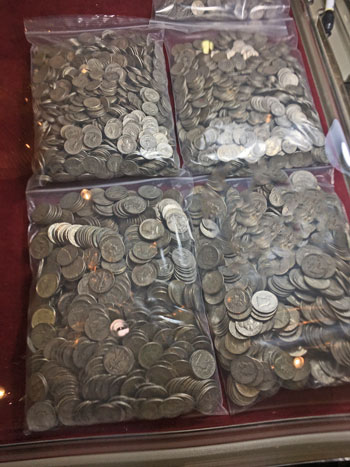


Of course, with the increase in silver prices, there was an increased interest by both dealers and visitors in the precious metal.
Our next collectible shows several bags of silver coins. These are circulated silver quarter dollars and half dollars.
As a result of all the wear and tear of circulation, these coins are worth more as silver than they are as old coins.
The silver half dollar coin bags are generally Barbers, Walking Liberties, Franklins and/or Kennedys, provided they are 90% silver.
In the quarter dollar coin bags, there can be Barbers, Standing Liberties and Washingtons containing 90% silver.
Our next collectible shows several bags of silver coins. These are circulated silver quarter dollars and half dollars.
As a result of all the wear and tear of circulation, these coins are worth more as silver than they are as old coins.
The silver half dollar coin bags are generally Barbers, Walking Liberties, Franklins and/or Kennedys, provided they are 90% silver.
In the quarter dollar coin bags, there can be Barbers, Standing Liberties and Washingtons containing 90% silver.
Some people are interested in full bags, which equates to $1000 in face value.
Some prefer smaller quantities such as half bags (easier to carry).
One thing to be careful of when buying coins as bullion silver is to make sure the bags weigh correctly.
Several old coins were heavily circulated, as such, they can be worn thin. Thin coins do not contain the original amount of silver.
For example, the silver quarter dollar weighed 6.25 grams, which equals 0.2009422 troy ounce. At 90%, the quarter should contain 0.18084798 troy ounce of silver.
A bag containing 4000 quarters should weigh 803.7688 troy ounces and contain 723.39192 troy ounces of silver.
Some prefer smaller quantities such as half bags (easier to carry).
One thing to be careful of when buying coins as bullion silver is to make sure the bags weigh correctly.
Several old coins were heavily circulated, as such, they can be worn thin. Thin coins do not contain the original amount of silver.
For example, the silver quarter dollar weighed 6.25 grams, which equals 0.2009422 troy ounce. At 90%, the quarter should contain 0.18084798 troy ounce of silver.
A bag containing 4000 quarters should weigh 803.7688 troy ounces and contain 723.39192 troy ounces of silver.
A side note, precious metals are weighed in troy ounces, and their market price is per troy ounce. One avoirdupois ounce (how we generally weigh goods) equals 0.9114582357508 troy ounce.
Similarly, a silver half dollar coin should weigh 12.5 grams or 0.4018843 troy ounce.
A full bag of 2000 coins should weigh 803.7686 troy ounces and contain 723.39174 troy ounces of silver.
At least to two digits after the decimal point, the bags of silver are the same whether half dollars or quarter dollars.
And, that's by design not happenstance.
Anyway, bags of silver coins could be found on the August bourse for those interested in coins as bullion silver.
Similarly, a silver half dollar coin should weigh 12.5 grams or 0.4018843 troy ounce.
A full bag of 2000 coins should weigh 803.7686 troy ounces and contain 723.39174 troy ounces of silver.
At least to two digits after the decimal point, the bags of silver are the same whether half dollars or quarter dollars.
And, that's by design not happenstance.
Anyway, bags of silver coins could be found on the August bourse for those interested in coins as bullion silver.
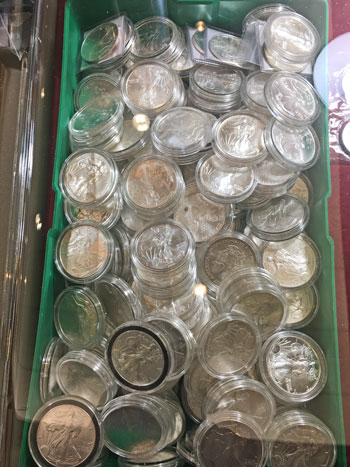
Another favorite among silver connoisseurs is the American Silver Eagle Dollar Coins.
Begun in 1986, these coins display the A. A. Weinman Walking Liberty design on the obverse and John Mercanti's heraldic eagle on the reverse.
In a letter to the Director of the Mint, A. A. Weinman described his Walking Liberty design:
“In my design for the half dollar, I have decided on a full length female figure of Liberty and have represented her enveloped in the folds of the Stars and Stripes, progressing in full stride toward the glorious dawn of a new day, carrying branches of laurel and of oak symbolical of civil and of military glory.
"Her right hand is outstretched in bestowal of the spirit of liberty to the land of the free and the home of the brave."
Mr. Weinman's design remains popular today with both collectors and investors.
With a denomination of one dollar, these coins have always had more than a dollar value from both a collectible and a precious metal perspective.
Begun in 1986, these coins display the A. A. Weinman Walking Liberty design on the obverse and John Mercanti's heraldic eagle on the reverse.
In a letter to the Director of the Mint, A. A. Weinman described his Walking Liberty design:
“In my design for the half dollar, I have decided on a full length female figure of Liberty and have represented her enveloped in the folds of the Stars and Stripes, progressing in full stride toward the glorious dawn of a new day, carrying branches of laurel and of oak symbolical of civil and of military glory.
"Her right hand is outstretched in bestowal of the spirit of liberty to the land of the free and the home of the brave."
Mr. Weinman's design remains popular today with both collectors and investors.
With a denomination of one dollar, these coins have always had more than a dollar value from both a collectible and a precious metal perspective.
Gold prices also increased significantly and a variety of gold coins could be found at the coin show.
This image shows a line of Kruggerands at the bottom and Coronas at the top.
Most of the Coronas are Austrian from 1915. They are probably re-strikes of the 20 Corona coins produced by the Austrian Mint, all of which are dated 1915 and in Roman numerals, MDCCCCXV.
In particular, the coins contain 0.1960 troy ounce of gold.
One side has a right-facing head of Franz Joseph I, Emperor of the Austro-Hungarian Empire and King of Hungary. Franz Joseph I died in November 1916 while the empire fought World War I on the side of the German Empire.
The other side shows an Imperial Austrian eagle, the date and the denomination of 20 Corona. This design represents the crowned arms of the Austro-Hungarian Empire. The crest in the center is supported by a double-headed eagle with a single crown situated above.
One of these is different and is a 1908 Hungarian 20 Korona gold coin, which also contains 0.1960 troy ounce of gold, and was issued by Austria-Hungary.
The obverse side of the 20 Korona Gold Coins show the right facing figure of Franz Joseph I as he stands wearing a crown on his head. There is a scepter resting on his right shoulder and his left hand extends clutching a sphere. This design is unique to the Korona coinage of Hungary and was never used on Austrian Krones.
This image shows a line of Kruggerands at the bottom and Coronas at the top.
Most of the Coronas are Austrian from 1915. They are probably re-strikes of the 20 Corona coins produced by the Austrian Mint, all of which are dated 1915 and in Roman numerals, MDCCCCXV.
In particular, the coins contain 0.1960 troy ounce of gold.
One side has a right-facing head of Franz Joseph I, Emperor of the Austro-Hungarian Empire and King of Hungary. Franz Joseph I died in November 1916 while the empire fought World War I on the side of the German Empire.
The other side shows an Imperial Austrian eagle, the date and the denomination of 20 Corona. This design represents the crowned arms of the Austro-Hungarian Empire. The crest in the center is supported by a double-headed eagle with a single crown situated above.
One of these is different and is a 1908 Hungarian 20 Korona gold coin, which also contains 0.1960 troy ounce of gold, and was issued by Austria-Hungary.
The obverse side of the 20 Korona Gold Coins show the right facing figure of Franz Joseph I as he stands wearing a crown on his head. There is a scepter resting on his right shoulder and his left hand extends clutching a sphere. This design is unique to the Korona coinage of Hungary and was never used on Austrian Krones.
The opposite side of the 20 Korona Hungarian Gold Coins is a design known both as the crowned arms of Hungary and as the coat of arms of the Habsburgs. The House of Habsburg ruled the Austro-Hungarian Empire from its founding until it was dissolved after its defeat in World War I. The central crowned shield comes from the Habsburgs, and the addition of the angelic messengers supporting it forms the royal arms of Hungary.
Side note, the Habsburg name is also represented as Hapsburg as the English spelling of the name.
In any case, these coins, with 0.1960 troy ounce of gold, are excellent introductory coins for gold investing.
The gold 1979 Kruggerands contain 1 troy oz of Gold minted by the South African Mint.
The obverse design shows the likeness of Paul Kruger, South Africa’s first and only president, along with “South Africa” in Afrikaans and English.
On the reverse, a Springbok antelope, the national animal of South Africa, shows along with the year of minting and the gold weight.
Though they are smaller in diameter, the Kruggerands are more valuable since they each contain a full troy ounce of fine gold.
Side note, the Habsburg name is also represented as Hapsburg as the English spelling of the name.
In any case, these coins, with 0.1960 troy ounce of gold, are excellent introductory coins for gold investing.
The gold 1979 Kruggerands contain 1 troy oz of Gold minted by the South African Mint.
The obverse design shows the likeness of Paul Kruger, South Africa’s first and only president, along with “South Africa” in Afrikaans and English.
On the reverse, a Springbok antelope, the national animal of South Africa, shows along with the year of minting and the gold weight.
Though they are smaller in diameter, the Kruggerands are more valuable since they each contain a full troy ounce of fine gold.
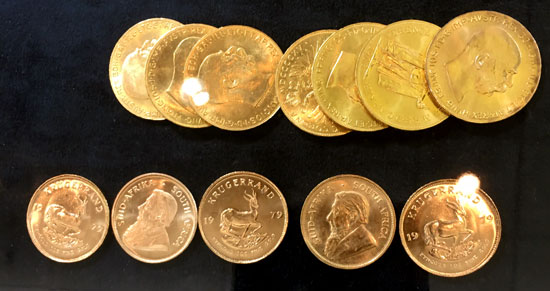
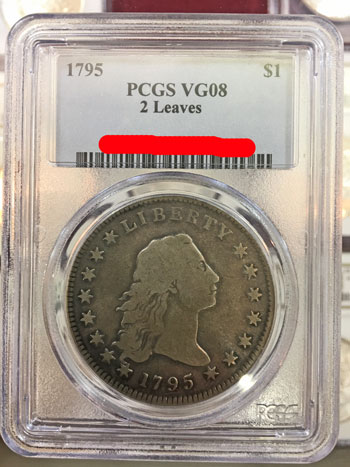

Now, let's go back in time with this 225-year old silver dollar.
The Mint, whose location was only Philadelphia in 1795, produced 160,295 of the Flowing Hair Silver Dollar Coins in that year.
However there are varieties. One has two leaves under each of the eagle's wings. Another has three leaves.
The quantities of each are unknown, however the Red Book shows the two leaves variety having more value in the higher grades. The values of the two varieties are comparable in the lower grades.
PCGS (Professional Coin Grading Service) graded this specimen as VG08. Their population report speculates only 4000 of this variety exists.
However, they have graded coins from AG02 (About Good) all the way to two MS65 Flowing Hair Dollar Coins. (Wouldn't those two be amazing?)
The Mint, whose location was only Philadelphia in 1795, produced 160,295 of the Flowing Hair Silver Dollar Coins in that year.
However there are varieties. One has two leaves under each of the eagle's wings. Another has three leaves.
The quantities of each are unknown, however the Red Book shows the two leaves variety having more value in the higher grades. The values of the two varieties are comparable in the lower grades.
PCGS (Professional Coin Grading Service) graded this specimen as VG08. Their population report speculates only 4000 of this variety exists.
However, they have graded coins from AG02 (About Good) all the way to two MS65 Flowing Hair Dollar Coins. (Wouldn't those two be amazing?)
The ANA Grading Standards defines VG08 for the Flowing Hair Dollar Coin as "Well worn. Design is clear but flat and lacking details."
In addition, they show for each side of the coin:
"Obverse: Entire head is weak, and most hair details are worn smooth. Date and LIBERTY are weak but visible. Parts of the eye and ear are visible. Stars are outlined.
"Reverse: Eagle is boldly outlined with only a few details showing in wings and tail. Breast is smooth. Some letters are very weak."
At 225 years old, just think of the hands that held this coin and the exchanges made for goods and services throughout its circulation lifetime.
Oh, the tales this coin could tell.
It's survival is a wonder, and it may not make the Fine, About Uncirculated or Mint State grades, but it's a very nice coin, nonetheless.
In addition, they show for each side of the coin:
"Obverse: Entire head is weak, and most hair details are worn smooth. Date and LIBERTY are weak but visible. Parts of the eye and ear are visible. Stars are outlined.
"Reverse: Eagle is boldly outlined with only a few details showing in wings and tail. Breast is smooth. Some letters are very weak."
At 225 years old, just think of the hands that held this coin and the exchanges made for goods and services throughout its circulation lifetime.
Oh, the tales this coin could tell.
It's survival is a wonder, and it may not make the Fine, About Uncirculated or Mint State grades, but it's a very nice coin, nonetheless.
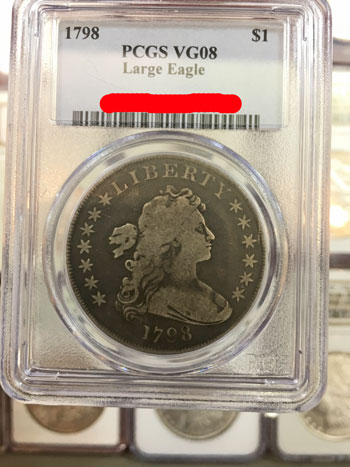

Staying in the early days of the Mint, the next coin is a 1798 Draped Bust Silver Dollar Coin of the Large Eagle variety.
The Draped Bust Silver Dollar began in 1795, and the Mint continued their production into 1803. (The design was also used in the 1804 dollar, but that's a whole different story.)
However, the coin's reverse began as a small eagle and changed in 1798 to a larger, heraldic eagle design.
The Red Book shows a total mintage of the Draped Bust Silver Dollar Coin in 1798 as 327,536 to include both the small eagle and large eagle varieties in that year.
Interestingly, PCGS graded this coin as VG08 and show the population for this particular design as 287,536.
PCGS also estimates the survival rate for this coin as 5000 including all grades. They have graded specimens from AG01 to MS64.
The Draped Bust Silver Dollar began in 1795, and the Mint continued their production into 1803. (The design was also used in the 1804 dollar, but that's a whole different story.)
However, the coin's reverse began as a small eagle and changed in 1798 to a larger, heraldic eagle design.
The Red Book shows a total mintage of the Draped Bust Silver Dollar Coin in 1798 as 327,536 to include both the small eagle and large eagle varieties in that year.
Interestingly, PCGS graded this coin as VG08 and show the population for this particular design as 287,536.
PCGS also estimates the survival rate for this coin as 5000 including all grades. They have graded specimens from AG01 to MS64.
The ANA Grading Guide provides the same general description for the VG08 Draped Bust Dollar as shown above.
However, for the front and back designs, they define VG08 as:
"Obverse: Entire head is weak, and most hair details and drapery are worn smooth. Date and LIBERTY are weak but clear. Parts of the eye and ear are visible. Stars are outlined, with some tips worn flat.
"Reverse: Eagle is boldly outlined with only a few details showing in wings. Clouds, head, and top of shield are smooth. Some letters in legend are very weak; parts of motto are missing. Rim may be incomplete."
Regardless of its grade, this coin showcases yesterday's history and provides an example of the worn but lasting beauty from 222 years ago.
However, for the front and back designs, they define VG08 as:
"Obverse: Entire head is weak, and most hair details and drapery are worn smooth. Date and LIBERTY are weak but clear. Parts of the eye and ear are visible. Stars are outlined, with some tips worn flat.
"Reverse: Eagle is boldly outlined with only a few details showing in wings. Clouds, head, and top of shield are smooth. Some letters in legend are very weak; parts of motto are missing. Rim may be incomplete."
Regardless of its grade, this coin showcases yesterday's history and provides an example of the worn but lasting beauty from 222 years ago.
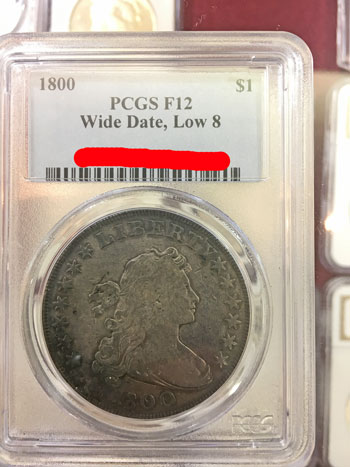
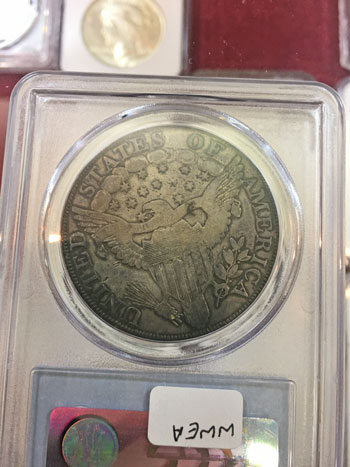
Our last example is another early mint coin, another silver dollar and another Draped Bust variety from 1800.
The Philadelphia Mint struck 220,920 of the Draped Bust Silver Dollar Coins in 1800 with several varieties. Remember, their processes were good in the early days but not as mechanized as today. Varieties could occur, some human generated and some caused by their early machines.
This example, graded by PCGS as F12 (Fine 12) is one of the Wide Date, Low 8 varieties.
Basically, this means the digits in 1800 are spread apart with the "8" dropped below the adjacent numbers.
PCGS speculates only 125 of these coins, across all grades, still exist. They have graded this type of dollar coin from AG03 to MS64+.
The ANA Grading Guide defines the F12 grade for the Draped Bust Dollar of this year as, "Moderate to heavy even wear. Entire design is clear and bold."
The Philadelphia Mint struck 220,920 of the Draped Bust Silver Dollar Coins in 1800 with several varieties. Remember, their processes were good in the early days but not as mechanized as today. Varieties could occur, some human generated and some caused by their early machines.
This example, graded by PCGS as F12 (Fine 12) is one of the Wide Date, Low 8 varieties.
Basically, this means the digits in 1800 are spread apart with the "8" dropped below the adjacent numbers.
PCGS speculates only 125 of these coins, across all grades, still exist. They have graded this type of dollar coin from AG03 to MS64+.
The ANA Grading Guide defines the F12 grade for the Draped Bust Dollar of this year as, "Moderate to heavy even wear. Entire design is clear and bold."
Specifically for the sides of the coin:
"Obverse: Some details show in hair ends, curls, and at left of ear. Date, all letters, and stars are visible. The eye and ear are clear. Bust is worn with a few drapery lines remaining.
"Reverse: Half the feathers are visible in the wings. Breast and head are smooth. Letters in legend are worn but clear. Clouds and top of shield show considerable wear."
It's interesting to view the PCGS MS64+ version on their web site.
However, this coin is more affordable and still showcases the Draped Bust Silver Dollar Coin design with its Wide Date, Low 8 variety.
In other words, this is a very nice 220 year old coin.
"Obverse: Some details show in hair ends, curls, and at left of ear. Date, all letters, and stars are visible. The eye and ear are clear. Bust is worn with a few drapery lines remaining.
"Reverse: Half the feathers are visible in the wings. Breast and head are smooth. Letters in legend are worn but clear. Clouds and top of shield show considerable wear."
It's interesting to view the PCGS MS64+ version on their web site.
However, this coin is more affordable and still showcases the Draped Bust Silver Dollar Coin design with its Wide Date, Low 8 variety.
In other words, this is a very nice 220 year old coin.
Our September 2020 Greater Atlanta Coin Show is still scheduled and will occur unless we are forced to close by state, county, local, hotel or COVID-19 officials.
As usual, the dealers will fill the bourse with their displays of a variety of treasures such as coins, currency, bullion, exonumia, scripophily, semi-precious stones, jewelry and other intriguing items.
Most of our regular dealers will be there with some visiting dealers filling in for the few of our dealers who, for health reasons, are choosing to wait for the virus to subside more.
All visitors to the show are welcome whether buying, selling, trading or just looking at the many different items.
As usual, the dealers will fill the bourse with their displays of a variety of treasures such as coins, currency, bullion, exonumia, scripophily, semi-precious stones, jewelry and other intriguing items.
Most of our regular dealers will be there with some visiting dealers filling in for the few of our dealers who, for health reasons, are choosing to wait for the virus to subside more.
All visitors to the show are welcome whether buying, selling, trading or just looking at the many different items.
Whether you are an experienced collector or investor or someone new to a coin show, there will be knowledgeable dealers that can help you with your search.
Visitors may also bring items to the show for a free verbal appraisal, and if desired, offer to sell those collectibles to one or more dealers at the show.
IMPORTANT: Beginning with the September Coin Show, masks WILL BE REQUIRED to enter the show due to the continued concern about the virus situation.
Visit the next Greater Atlanta Coin Show on Sunday, September 13, 2020 in the Joe Mack Wilson ballroom to buy, sell, trade or just browse among the many items on display.
Visitors may also bring items to the show for a free verbal appraisal, and if desired, offer to sell those collectibles to one or more dealers at the show.
IMPORTANT: Beginning with the September Coin Show, masks WILL BE REQUIRED to enter the show due to the continued concern about the virus situation.
Visit the next Greater Atlanta Coin Show on Sunday, September 13, 2020 in the Joe Mack Wilson ballroom to buy, sell, trade or just browse among the many items on display.
